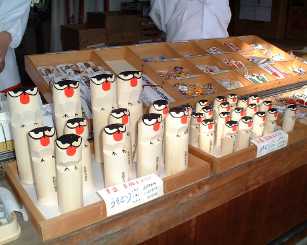|
Nishine-seki(weir)
On the heights which is between Fukushima and Miyagi border,
and is spreading to the west of the Abukuma River, lay 33 villages
and were called Nishine-go. The land there was fertile but not well
irrigated. Therefore, people grew only wheat and Japanese millet there
for several hundred years. When Zenbei Fukurawa became the feudal
commissioner in this area, he planned to build the weir and carried
it out. It took about 9 months to complete the project. The weir was
built between Iizaka and Kunimi-machi. In March, 1625, another weir,
which was 30 kilometers long was completed. It covered the area between
Iizaka and Yanagawa-machi. As a result, rice fields spread out in
the area since the dawn of history. With its completion, the rice
fields began to wave their golden ears. Farmers were not forced to
work in this project. Instead, laborers were hired and paid. It cost
57,000"ryo" (an old Japanese currency). Nishine Weir is still used
not only for farming, fire prevention but also for industry.
|
 Takahata Tenman-gu was built in the Edo era.
It is related to Kitano-Tenman-gu in Kyoto. Tenman-gu is the Shrine
dedicated to Sugawara Michizane who was born in the year of the Ox and
was the Heian scholar statesman. Many shrine lots were tied to trees
in the precincts of the Shrine. There is the "Sacred Ox" enshrined in
the precincts of the Shrine. It is believed that if a sick person strokes
the Sacred Ox, he or she will soon get well. Especially if stroked on
its head, he or she'll be blessed with wisdom.
Takahata Tenman-gu was built in the Edo era.
It is related to Kitano-Tenman-gu in Kyoto. Tenman-gu is the Shrine
dedicated to Sugawara Michizane who was born in the year of the Ox and
was the Heian scholar statesman. Many shrine lots were tied to trees
in the precincts of the Shrine. There is the "Sacred Ox" enshrined in
the precincts of the Shrine. It is believed that if a sick person strokes
the Sacred Ox, he or she will soon get well. Especially if stroked on
its head, he or she'll be blessed with wisdom.